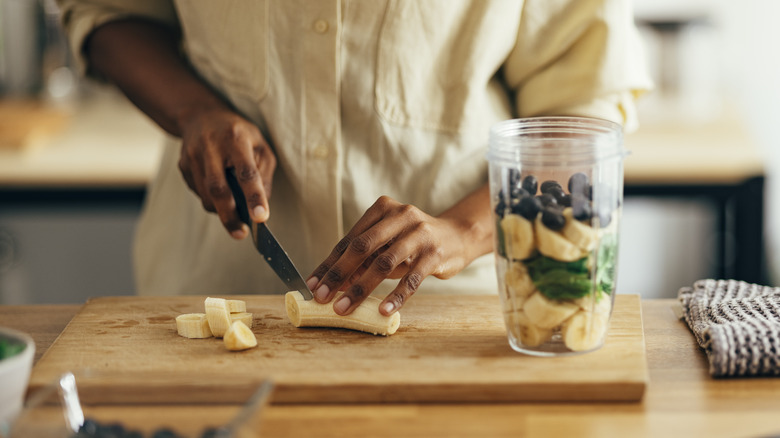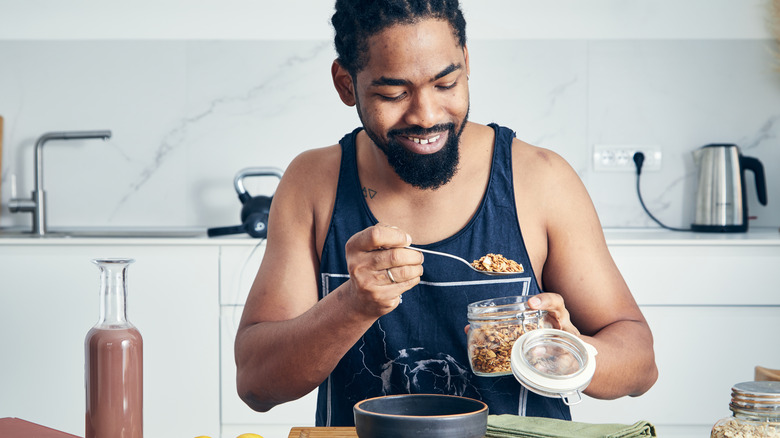When You Eat Bananas Every Day, This Is What Happens To Your Blood Pressure
Your heart beats about 100,000 times a day. If you want to know how hard your heart works, squeeze a tennis ball. Now squeeze that tennis ball 100,000 times. Your forearm might get tired after about 100 squeezes, but your heart must continue to do the work to pump blood through your body. Certain lifestyle factors such as smoking, use of narcotics, too much alcohol or caffeine, lack of sleep, and being sedentary force your heart to squeeze a little harder.
Let's not forget diet. Unhealthy foods can raise your blood pressure, and many of these unhealthy foods are high in sodium. Sodium increases your blood pressure by retaining more fluid in your body, which causes a higher volume of blood to circulate through your arteries and veins. According to the U.S. Food & Drug Administration, most Americans take in 3,400 milligrams of sodium a day, yet it's recommended to keep your sodium levels below 2,300 milligrams. That's just a single teaspoon of salt.
Enter potassium. Potassium works with sodium to keep your fluid levels in balance and it helps reduce your blood pressure. Most people don't get the recommended amount of potassium a day. Women need 2,600 milligrams a day, men need 3,400. What's a good source of potassium to lower your blood pressure? Bananas.
Potassium in bananas lowers blood pressure
While low-carb and keto dieters might steer clear of a banana because it has 113 calories and 26 grams of carbohydrates, that same banana provides 375 milligrams of potassium. That's more than 10% of the recommended amount of potassium for men and almost 15% for women. Starting every day with a banana will kickstart fulfilling your daily potassium needs.
Although research hasn't focused on the direct effect of bananas on blood pressure, studies have investigated how potassium can reduce blood pressure. A 2020 review in the Journal of the American Heart Association looked at 32 clinical trials that used potassium supplements to lower blood pressure. Taking in at least 1,173 milligrams of potassium lowered people's blood pressure, especially among people with high blood pressure or whose diets were high in sodium. That's about three bananas.
However, you don't want to go overboard on potassium if you're already on medication for high blood pressure. Many blood pressure medications can cause an excessive buildup of potassium in the body. Having too much potassium in your blood can lead to health complications including arrhythmia, heart palpitations, muscle weakness, mood changes, upset stomach, vomiting, diarrhea, and numbness or tingling in the extremities.
It's important to balance your potassium and sodium
Rather than relying on potassium supplements to lower your blood pressure, you can get plenty of potassium through foods such as bananas, acorn squash, nuts, lentils, and yogurt. You'll also want to keep an eye on the balance of your sodium and potassium levels. If you consume more sodium than potassium, you'll be at a higher risk of cardiovascular disease. The National Institutes of Health suggests a 2 to 1 ratio of potassium to sodium to reduce your risk of cardiovascular disease. You can do this by looking at the sodium levels of the foods you currently eat and reducing them from your diet. Eventually, your taste buds will get used to less sodium.
The Dietary Approaches to Stop Hypertension (DASH) Eating Plan encourages foods that are rich in potassium, like bananas, while reducing sodium, fatty meats, full-fat dairy, and sweets to lower your blood pressure and cholesterol. If you can't cook heart-healthy foods at home, the American Heart Association has a Heart-Check symbol on many of the food packages you see at the store. This symbol certifies that the food is low in saturated fat, trans fat, and sodium to keep your heart beating strong.



